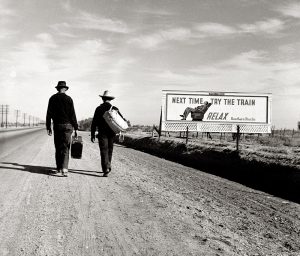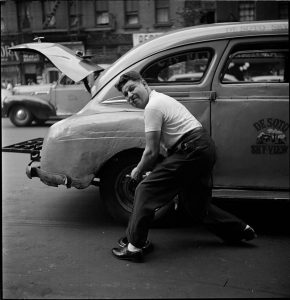 “Toward Los Angeles.”California,
“Toward Los Angeles.”California,
March 1937 by Dorothea Lange for FSA
“Next Time Try The Train– Relax.”
Lange captioned this with the walkers own words: “Well– give me the fare and I will, buddy. We ain’t walkin’ for our health…”
 Changing the Tire, Photograph by
Changing the Tire, Photograph by
Stanley Kubrick, 1946, for Look Magazine
Not many people think of Stanley Kubrick as a still photographer. After all, the creator of such monumental classics as 2001: A Space Odyssey, Dr. Strangelove and Lolita is etched in our brain as the grand American cinematic auteur.
But, even before all that, he was roaming the streets of New York City, grabbing life as he knew it. He did assignments for major publications of that era, and apprenticed with and later became a staff photographer for LOOK magazine, one of the two giant picture magazine (the other being LIFE).

At LOOK he photographed such greats as Frank Sinatra and Erroll Garner to George Lewis, , Papa Celestin, Alphonse Picou, Muggsy Spanier, Sharkey Bonano, and many of the greatest jazz musicians of the New York scene. It wasn’t until 1948 that Kubrick took an interest in cinema after viewing films at the Museum of Modern Art’s film screenings.
For more on Kubrick: https://twistedsifter.com/2011/12/stanley-kubricks-new-york-photos-1940s/
and: https://en.wikipedia.org/wiki/Stanley_Kubrick
Tenant farmer moving his household goods to a new farm.
Hamilton County, Tennessee, Rothstein, Arthur, 1937 (LOC)
Ten Children, March 1937, by Dorothea Lange,
for the RA (courtesy of OMCA)